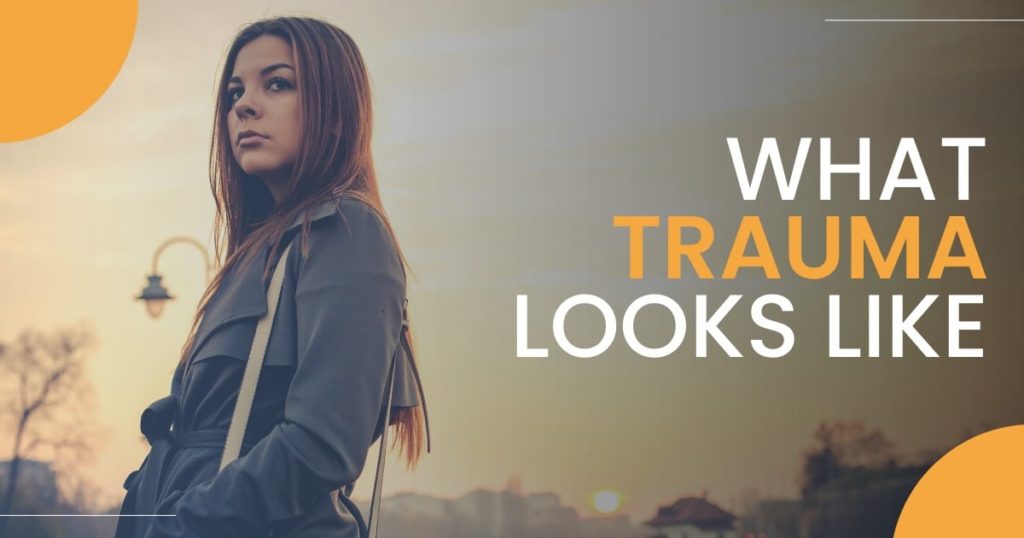What trauma looks like can be different for every person, and the experience of trauma can also vary significantly between individuals. Understanding what trauma looks like can help you identify symptoms in yourself or someone you love, which can be the first step to getting treatment for the symptoms/side effects of trauma and the reactions to trauma that someone may be experiencing.
What is Trauma?
When someone goes through something life-threatening, distressing, or exceptionally frightening, it’s trauma. We can experience psychological and emotional trauma, and the term can also be used as an umbrella to describe situations we feel are traumatic and how we’re affected by these experiences.
What someone finds traumatic is personal to them. Other people cannot tell you whether or not an experience is traumatic for you because it’s about your experiences and how you feel. You could have experienced similar to what someone else goes through yet feel completely different about it and have other effects, according to organizations like the American Psychiatric Association and the American Psychological Association.
Situations that can lead to traumatic stress symptoms can include feeling:
- Rejected
- Threatened
- Frightened
- Abandoned
- Unsafe
- Trapped
- Powerless
- Ashamed
Trauma can happen due to one-off events or things that are ongoing. Being directly harmed can cause trauma, as can witnessing harm to someone else. Living in a traumatic environment or being affected by community or family trauma can also cause these feelings.
For some people, the experience of trauma relates to facets of their identity. For example, if you’ve experienced bullying, harassment or discrimination, these experiences are traumatic in many cases.
Specific situations that can be traumatic include:
- The loss of a parent or caregiver in childhood
- Sexual violence
- Physical violence
- Being in a car accident
- Military combat experience (PTSD is especially common among military personnel)
- Traumatic brain injury
- Experiencing severe injuries of any kind
- Child abuse
- The unexpected loss of a loved one
Types of Trauma
Trauma can be categorized into subtypes, including:
- Acute trauma reflects the intense distress someone might feel immediately following a one-time event. A car crash or an assault can lead to acute trauma, which can also contribute to the development of acute stress disorder.
- Chronic trauma comes from prolonged, ongoing events. These events over a period of time might include domestic violence, emotional abuse, physical abuse or sexual abuse, or bullying. Neglected children can also experience chronic trauma.
- Complex trauma comes from experiencing repeated traumatic events where there’s no way to escape. The feeling of being trapped is what characterizes complex trauma. When someone goes through complex trauma, it can make them feel like they aren’t safe in the world and lead to hypervigilance.
- Secondary or vicarious trauma comes from exposure to the suffering of other people. First responders, law enforcement, and health care professionals are often affected by secondary trauma.
- Adverse childhood experiences cover many situations a child might face when growing up before they have coping skills. Divorce, childhood sexual or physical abuse, or neglect can lead to adverse childhood experiences. Responses to child experiences and the effects of child experiences of trauma can affect cognitive patterns and last well into adulthood for some people.
How Does Trauma Affect You?
When you experience something distressing or disturbing, it activates your amygdala, which is part of your brain responsible for detecting threats.
- The amygdala responds to threats by sending out an “alarm” to other systems in your body, preparing you to go on defense.
- These are normal reactions and responses to upsetting or scary events, and physiological reactions occur when facing something threatening.
- Your blood vessels can restrict, and more blood is being pushed toward your muscles in response to a perceived threat.
- The sympathetic nervous system starts its common reactions by releasing many stress hormones. Fear, shock, and anxiety are common during threatening situations.
Negative feelings following a traumatic stress reaction will often fade over time. For some people, however, these distressing feelings continue and interfere with their daily life.
Someone with long-term trauma can develop extreme sadness, guilt, or anger. Survivors’ guilt, disassociation, or post-traumatic stress disorder can also occur.
A person with traumatic experiences in their life will constantly be in defense mode for extended periods.
What Trauma Looks Like
What trauma looks like and the symptoms/side effects of trauma or post-traumatic stress disorder aren’t always immediately apparent.
Some of the common symptoms and signs of trauma include:
- Experiencing intrusive memories or thoughts
- Nightmares
- Memory loss
- Problems with focus and concentration
- Mood swings
- Anger and similar behavioral reactions and emotional symptoms
- Disorientation
- Nightmares
- Avoiding places that are reminders of the event
- Withdrawal from friends and family
- Loss of interest in once-enjoyed activities
- Easily startled
- Fatigue and exhaustion
- Edginess
- Insomnia
- Sexual dysfunction
- Changes in patterns of eating and sleeping
- Physical symptoms like aches and pains
- Extreme alertness
- Panic attacks
- Emotional numbing or dulled emotional responses and emotional reactions
- Obsessive and compulsive behaviors
- Detachment from emotions and other people and other psychological symptoms
- Irritability
When trauma is untreated, it can lead to complications and effects like:
- Substance abuse and substance use disorders
- Sexual problems
- The inability to maintain close relationships
- Hostility
- Aggressive behavior
- Physical reactions to triggers or traumatic memories
- Arguments with loved ones
- Feelings of being threatened constantly
- Self-injurious behaviors
- Self-destructive behaviors
- Development of anxiety disorders
- Impulsivity
- Reactive thoughts that are out-of-control
- An inability to make healthy decisions
- Symptoms of dissociation
- Depression, despair, shame, or hopelessness
- Feeling like you’re permanently damaged
- Changes in sleep patterns or eating patterns
- Compulsive patterns of behavior
Misconceptions About Trauma
A few misconceptions about trauma and trauma-related symptoms often float around.
One is that all childhoods are traumatic. Sometimes, there is a view or assumption that since all childhoods are distressing at some point, every childhood includes actual psychological trauma. This can lead people to question their experiences as they grew up or their caretakers, which may be unfounded doubts.
Another misconception is that trauma ruins your life forever. If someone has traumatic experiences, they may take on the identity of a victim. They might start seeing slights that don’t exist or expect the world to hurt them. This doesn’t do people any good because it ignores our innate ability to grow through challenges. People who have experienced trauma can often work through the feeling of being a victim and instead reframe their perspective to be more positive, viewing themselves as survivors.
Finally, there’s also a misconception that talking about negative experiences and feelings will lead to healing. In reality, going over painful memories can be harmful to traumatic events. Everyone’s treatment and healing journey from trauma is going to be different.
Treating the Symptoms/Side Effects of Trauma
There are a lot of therapeutic approaches that can help people who have severe symptoms or side effects of trauma that they’re dealing with.
- Psychotherapy is one of the best approaches to treatment. Also known as talk therapy, these behavioral approaches help people identify and change their unhealthy thought patterns.
- There are also neurological therapies, like eye movement desensitization and reprocessing (EMDR). With this therapeutic approach, the use of repetitive eye movements helps interrupt and re-pattern trauma-related memories a person may have.
- In some cases, medications might be the appropriate treatment for someone with trauma symptoms, usually in addition to behavioral therapy.
- You can also make lifestyle modifications to help yourself, such as journaling, practicing mindfulness meditation, or healthy habits like eating and sleeping well.
Mental Health Treatment for Teens in Southern California
Please contact Hillside Horizon for Teens today by calling 855-746-8378 if you’d like to learn more about what trauma looks like or the therapeutic and treatment options to help with the symptoms. We can connect you with our team of mental health professionals who can help you navigate your experiences, emotional reactions, and physical symptoms and explore individualized treatment for post traumatic stress disorder.
If you’d like to discuss other mental illnesses or mental disorders and available treatment programs, we can also help you with those topics.





